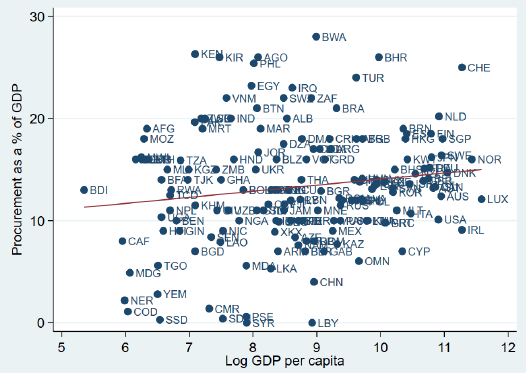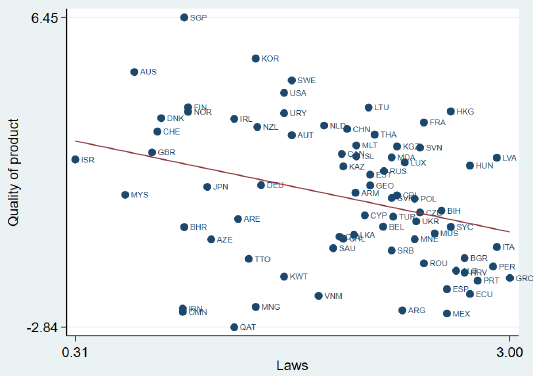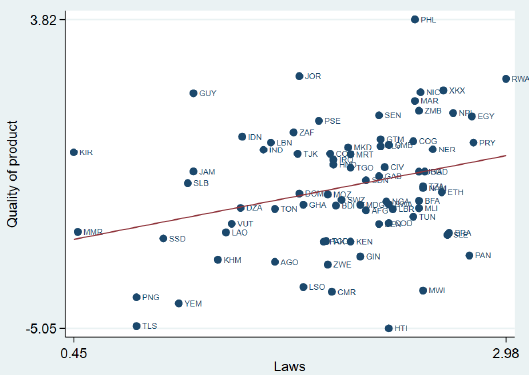
Heavier regulation of procurement is associated with better outcomes in countries with lower quality public sectors, and with worse outcomes in countries with higher quality ones
Public procurement — the process by which governments purchase goods, services and works from the private sector — amounted to US$11 trillion out of global GDP of nearly $90 trillion in 2018. In other words, 12% of global GDP is spent following procurement regulation (Figure 1).
The size of public procurement as a share of GDP is nearly identical across low-income, middle-income, and high-income countries. Amongst the countries we studied, low-income economies procure on average 13% of GDP in goods, services, and works. Middle-income countries procure 13.2% of GDP, and high-income countries procure 14% of GDP. These differences are statistically insignificant, i.e. they are roughly the same and are indistinguishable from each other.
Figure 1 Public procurement as a share of GDP

A cross-country study of procurement laws and practices
In a recent paper (Bosio et al. 2020), we provide a panoramic overview of procurement laws and practices across 187 countries. Since 2017, the World Bank has administered a new pilot module on procurement as part of its Doing Business project. Respondents in each of the countries (typically eight to twelve professionals ranging from public procurement lawyers to road construction companies and procuring entities) were presented with a hypothetical $2.5 million road maintenance project. They were asked about the rules that would govern the procurement of such a project. Based on their answers, we constructed measures of laws governing procurement, covering transparency, competition, exclusion of bidders, and integrity of contracts. Respondents also described whether and how procurement practices differed from the laws, which enabled us to create corresponding measures of regulatory practice.
We also elicited expert opinions on three outcomes: (1) perceived corruption, (2) an index on the efficiency of process covering favouritism, collusion, and absence of competition, and (3) an index on the quality of product covering cost overruns, time delays, and low quality. The correlation coefficient between process and product is 0.60, indicating that countries with qualitative products also tend to have efficient processes. Corruption, in turn, is associated with bad process and product. We tested how these procurement outcomes varied with laws and practices, as well as with level of development.
Heterogeneous relationship between procurement laws and outcomes
The scoring of outcomes leads to an unsurprising list of best and worst countries. On quality of product, the worst are Venezuela, Haiti, and Timor Leste, and the best are Singapore, Korea, and Australia. On efficiency of process, the worst are Niger, Lao, and Myanmar; the best are Germany, Denmark, and Norway.
Overall, we find that procuring entities around the world are typically highly regulated, but while these regulations are everywhere associated with less corruption, they are not universally associated with improvements along other dimensions. That presents a puzzle because although laws predict practice and practice predicts outcomes, laws do not predict outcomes. The key to this puzzle is that the overall relationship between laws and outcomes misses critical heterogeneity. Laws improve outcomes when public sector capacity is low, and harm outcomes when public sector capacity is high. As a result, regulation of procurement helps, but only in poor countries.
We also divide countries by the World Bank’s Human Capital Index and government effectiveness index. These are highly – though not perfectly – correlated with income per capita. Heavier regulation of procurement is associated with better outcomes in countries with lower quality public sectors, and with worse outcomes in countries with higher quality ones (Figures 2 and 3). If bureaucrats are accountable, rules that restrict their discretion do more harm than good. When bureaucrats are not accountable, rules limit their misconduct. Procurement-specific rules are less important than the overall quality of government or national human capital for procurement outcomes. Well educated countries with capable governments achieve good procurement outcomes no matter what rules they have on the books.
The evidence explains the puzzle that, overall, there is no relationship between procurement laws and outcomes – one needs to sort on government capacity in the analysis. The evidence is consistent with recent findings from better identified but more specific settings, which point to the benefits of bureaucratic discretion (Coviello et al. 2018, Bandiera et al. 2020, Decarolis et al. 2020).
Figure 2 Law and quality of product in high human capital countries

Figure 3 Law and quality of product in low human capital countries

Laws and enforcement as substitutes
There is a broader point as well. In many settings, economists and legal scholars see laws and their enforcement as complements. Laws are more effective in countries with better judiciaries, bureaucracies, etc. In our paper we find the opposite: laws and enforcement capabilities are substitutes. Countries with weak bureaucracies need strict laws to regulate them, while countries with strong bureaucracies can lay off a little. This message has implications for the design of institutions in developing economies, particularly the regulation of government.
References
Bandiera, O, M C Best, A Q Khan and A Prat (2020), “The allocation of authority in organizations: A field experiment with bureaucrats”, mimeo, London School of Economics.
Bosio, E, S Djankov, E L Glaeser and A Shleifer (2020), “Public procurement in law and practice”, NBER Working Paper No. 27188.
Coviello, D, A Guglielmo and G Spagnolo (2018), “The effect of discretion on procurement performance”, Management Science 64(2):715-738.
Decarolis, F, G Spagnolo and R Pacini (2020), “Past performance and procurement outcomes”, NBER Working Paper No. 22814.



